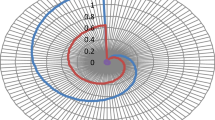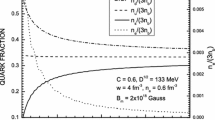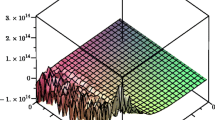Abstract
In this paper we study quark matter and strange quark matter in higher-dimensional spherical symmetric space-times. We analyze strange quark matter for the different equations of state and obtain the space-time geometry of quark and strange quark matter. We also discuss the features of the obtained solutions in the context of higher-dimensional general theory of relativity.
Similar content being viewed by others
References
Sahdev, D.: Phys. Rev. D 30, 2495 (1984)
Emelyanov, V.M., Nikitin, Y.P., Rozental, J.L., Berkov, A.V.: Phys. Rep. 143, 1 (1986)
Chatterjee, S., Bhui, B.: Int. J. Theor. Phys. 32, 671 (1993)
Overduin, J.M., Wesson, P.S.: Phys. Rep. 283, 303 (1987)
Randall, L., Sundrum, R.: Phys. Rev. Lett. 83, 3370, 4690 (1999)
Shen, Y., Tan, Z.: Phys. Lett. A 142, 341 (1989)
Paul, B.C.: Class. Quantum Gravity 18, 2311 (2001)
Kaluza, T.: Sitz.ber. Preuss. Akad. Wiss. Berl. Philos.-Hist. Kl. F1, 966 (1921)
Klein, O.: Ann. Phys. 37, 895 (1926)
Gondek-Rosinska, D., Gourgoulhon, E., Haensel, P.: Astron. Astrophys. 412, 777 (2003)
Kapusta, J.: Finite-Temperature Field Theory. Cambridge University Press, Cambridge (1994)
Sotani, H., Kohri, K., Harada, T.: Phys. Rev. D 69, 084008 (2004)
Xu, R.X.: Chin. J. Astron. Astrophys. 3, 33 (2003)
Dey, M., Bombaci, I., Dey, J., Ray, S., Samanta, B.C.: Phys. Lett. B 438, 123 (1998)
Gondek-Rosinska, D., Bulik, T., Zdunik, L., et al.: Astron. Astrophys. 363, 1005 (2000)
Sharma, R., Karmakar, S., Mukherjee, S.: Int. J. Mod. Phys. D 15, 405 (2006)
Yilmaz, I.: Gen. Relativ. Gravit. 38, 1397 (2006)
Back, B.B., et al.: Nucl. Phys. A 757, 28 (2005)
Admas, J., et al.: Nucl. Phys. A 757, 102 (2005)
Adcox, K., et al.: Nucl. Phys. A 757, 184 (2005)
Cahill, M.E., McVittie, G.C.: J. Math. Phys. 11, 1382 (1970)
Author information
Authors and Affiliations
Corresponding author
Appendix
Appendix
For the line element (5) the non zero component of \(R_{jij}^{i}\) is
where i=3,4,5,…,n j=2,3,4,…,n−1 and i>j.
Examination of this expression reveals that if R=r our line element (5) reduces to
If curvature coordinates used in empty region then spherically symmetric five dimensions (5D) Schwarzschild’s like metric is given by
where A is a constant and from Newtonian approximation A=M. Comparison of (43) and (44) gives
where the subscript b means evaluation at the boundary. We can, at this stage, follow the arguments of Cahill and McVittie [21] in defining intuitively a mass function in 5D as
Rights and permissions
About this article
Cite this article
Khadekar, G.S., Wanjari, R. Geometry of Quark and Strange Quark Matter in Higher Dimensional General Relativity. Int J Theor Phys 51, 1408–1415 (2012). https://doi.org/10.1007/s10773-011-1016-3
Received:
Accepted:
Published:
Issue Date:
DOI: https://doi.org/10.1007/s10773-011-1016-3




